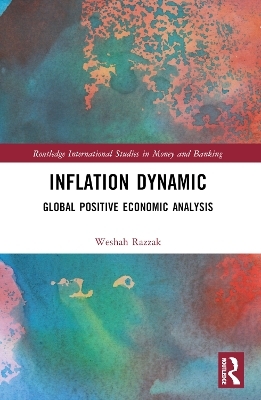
Inflation Dynamic
Global Positive Economic Analysis
Seiten
2024
Routledge (Verlag)
978-1-032-46547-0 (ISBN)
Routledge (Verlag)
978-1-032-46547-0 (ISBN)
The book tests various theoretical models about the relationships between money and prices, money growth and inflation, money growth and real output, expected inflation; the output gap, fiscal policy, and inflation, using a number of parametric and non-parametric methods, and pays attention to specifications and estimations problems.
This book explains inflation dynamic, using time series data from 1960 for 42 countries. These countries are different in every aspect, historically, culturally, socially, politically, institutionally, and economically. They are chosen on the basis of the data availability only and cover the Middle East and North Africa (MENA) region, Africa, Asia, the Caribbean, Europe, Australasia, and the United States.
Inflation reached double digits in the developed countries in the 1970s and 80s, and then central banks, successfully stabilized it by anchoring inflation expectations for decades, until now. Conditional on common and country-specific shocks such as oil price shocks, financial and banking and political crises, wars, pandemics, natural disasters etc., the book tests various theoretical models about the long and short run relationships between money and prices, money growth and inflation, money growth and real output, expected inflation; the output gap, fiscal policy, and inflation, using a number of parametric and non-parametric methods, and pays attention to specifications and estimations problems. In addition, it explains why policymakers in inflation – targeting countries, e.g. the U.S., failed to anticipate the recent sudden rise in inflation. And, it examines the fallibility of the Modern Monetary Theory’s policy prescription to reduce inflation by raising taxes.
This is a unique and innovative book, which will find an audience among students, academics, researchers, policy makers, analysts in corporations, private and central banks and international monetary institutions.
This book explains inflation dynamic, using time series data from 1960 for 42 countries. These countries are different in every aspect, historically, culturally, socially, politically, institutionally, and economically. They are chosen on the basis of the data availability only and cover the Middle East and North Africa (MENA) region, Africa, Asia, the Caribbean, Europe, Australasia, and the United States.
Inflation reached double digits in the developed countries in the 1970s and 80s, and then central banks, successfully stabilized it by anchoring inflation expectations for decades, until now. Conditional on common and country-specific shocks such as oil price shocks, financial and banking and political crises, wars, pandemics, natural disasters etc., the book tests various theoretical models about the long and short run relationships between money and prices, money growth and inflation, money growth and real output, expected inflation; the output gap, fiscal policy, and inflation, using a number of parametric and non-parametric methods, and pays attention to specifications and estimations problems. In addition, it explains why policymakers in inflation – targeting countries, e.g. the U.S., failed to anticipate the recent sudden rise in inflation. And, it examines the fallibility of the Modern Monetary Theory’s policy prescription to reduce inflation by raising taxes.
This is a unique and innovative book, which will find an audience among students, academics, researchers, policy makers, analysts in corporations, private and central banks and international monetary institutions.
Weshah Razzak is Honorary Research Fellow at the School of Economics and Finance, Massey University, Palmerston North, New Zealand.
List of Figures. List of Tables. Introduction. The Price Level and the Inflation the Data at a Glance: 1960–2021. The Quantity Theory of Money, Prices, and Output: The Equation of Exchange – the Quantity Theory of Money. Testing the Relationship Between Money and Prices. Money Growth and Inflation. The Neutrality of Money. Why Do Central Banks Print More Money?. The Phillips Curve, Anticipated Inflation, and Output. Estimating the Phillips Curve. The "Newer" Theories and Models of Inflation. Reducing Inflation. Summary and Conclusion. References. Index.
| Erscheinungsdatum | 17.05.2023 |
|---|---|
| Reihe/Serie | Routledge International Studies in Money and Banking |
| Zusatzinfo | 69 Tables, black and white; 134 Line drawings, black and white; 134 Illustrations, black and white |
| Verlagsort | London |
| Sprache | englisch |
| Maße | 156 x 234 mm |
| Gewicht | 660 g |
| Themenwelt | Geschichte ► Teilgebiete der Geschichte ► Wirtschaftsgeschichte |
| Wirtschaft ► Allgemeines / Lexika | |
| Wirtschaft ► Betriebswirtschaft / Management ► Finanzierung | |
| Wirtschaft ► Volkswirtschaftslehre ► Finanzwissenschaft | |
| Wirtschaft ► Volkswirtschaftslehre ► Makroökonomie | |
| ISBN-10 | 1-032-46547-6 / 1032465476 |
| ISBN-13 | 978-1-032-46547-0 / 9781032465470 |
| Zustand | Neuware |
| Informationen gemäß Produktsicherheitsverordnung (GPSR) | |
| Haben Sie eine Frage zum Produkt? |
Mehr entdecken
aus dem Bereich
aus dem Bereich
Macht und Herrschaft im Zarenreich
Buch | Hardcover (2024)
C.H.Beck (Verlag)
CHF 69,85


